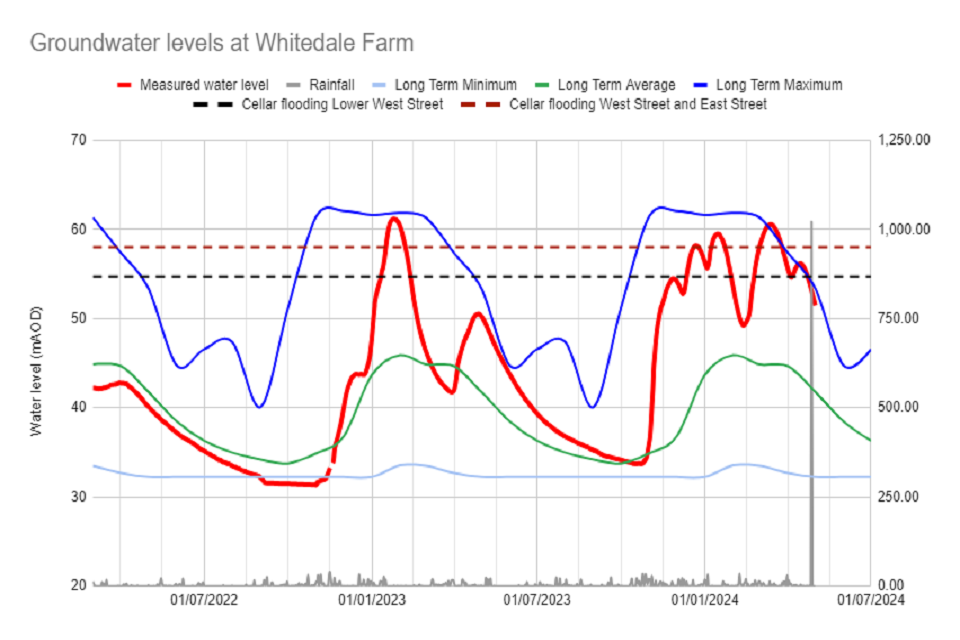Groundwater situation: Hampshire 2 May 2024
Updated 3 May 2024
Current situation
Groundwater levels in Hampshire remain high. In April 2024, heavy rainfall was recorded across Hampshire, with all of our rain gauges receiving between 120% and 220% of the long-term average for this month. A third of May’s long-term average rainfall has already been recorded in the first two days.
However, as temperatures rise and plants take up more water, groundwater levels are generally starting to fall across the county. Flooding impacts continue throughout Hampshire. Impacts include flooding to cellars, roads and land, as well impacts to sewerage networks and septic tanks.

Figure 1: Graph showing changes in groundwater levels in Oakley Borehole in North Hampshire from March 2022 to May 2024. The graph shows a steep incline in groundwater level from the end of October 2023 to the middle of January 2024. The level then remains stable until mid-February 2024, before another incline in groundwater level until mid-March 2024. Groundwater levels have been steadily declining since then.

Figure 2: Graph showing changes in groundwater levels in Hursley Borehole in central Hampshire from January 2022 to March 2024. The graph shows a steep incline in groundwater level from the end of October 2023 to mid-January 2024. The level then slowly declines until early-February 2024. The graph then shows another incline in groundwater level until mid-March 2024. Groundwater levels have been steadily declining since then.

Figure 3: Graph showing changes in groundwater levels in Whitedale Farm Borehole in East Hampshire from January 2022 to March 2024. The graph shows a steep incline in groundwater level from the end of October 2023 and a steep decline during January 2024. From mid-February 2024, the graph shows another steep incline in groundwater level until mid-March. Groundwater levels have generally been declining since then, and levels are currently below cellar flooding thresholds.
Forecast risk of flooding
Groundwater levels are generally slowly falling across most of Hampshire, although the recent heavy rainfall at the time of writing this briefing note has caused some levels to stabilise and even slightly rise in some cases. In most years, groundwater levels typically reach a peak in March or early April and then start to fall as winter rain eases, temperatures rise, and plants start to grow and take up water, and this is being reflected in the current trends.
Long range forecasting is difficult. The forecast is suggesting further rainfall, some of it possibly heavy, will affect Hampshire from Thursday 2 May 2024 to Monday 6 May 2024. After this, the weather is expected to turn more settled. Groundwater levels are expected to continue falling initially, but levels could begin to stabilise or even rise slightly in catchments where particularly heavy rain is recorded.
However, any rise in groundwater levels is not expected to be significant at this time of year. Overall, groundwater levels are expected to slowly fall over the coming months as we move from spring into summer. Groundwater flooding impacts are expected to continue throughout most of May and possibly into June in some locations. Any heavy or persistent rainfall recorded in the coming weeks will likely prolong flooding impacts.
Next update
We will update this groundwater situation document by 7 June 2024, or sooner if the risk of groundwater flooding significantly increases. When in force, groundwater Flood Alerts are updated with information more frequently.
What we are doing
We continue to monitor groundwater levels and their response to rainfall.
We will update this groundwater situation and our groundwater Briefing Notes during Spring 2024.
We will issue and update flood alerts when there is risk of flooding affecting property.
We will remove flood alerts when no further flood risk is expected.
We liaise with the local authority and other responding partners to ensure they are aware of the situation.
Our operational staff removing blockages from main rivers, to ensure they flow freely.
Actions and advice
Think and prepare now for what you’ll do if flooding occurs where you live, don’t wait until flooding happens.
Call Floodline on 0345 988 118 or visit check for flooding to find out if you can register to receive free flood alerts for flooding from groundwater.
Look for data in your area:
There is practical advice on what to do before, during and after groundwater flooding, and further guidance about groundwater flooding, how it might affect you and what to do.
Prepare a personal flood plan or community flood plan to help you and your community decide what practical actions to take before and during a flood, which will help reduce the damage flooding could cause.
Check pumps and any other flood protection equipment you have. Ensure valuables are moved from basements and other low parts of properties.
Where safe to do so, communities may wish to check and ensure there are no blockages in local watercourses and ditches.
Further information
You can view:
- daily groundwater levels compared to average and maximum, with indicative impact thresholds
- sub daily groundwater levels on Gaugemap
- the latest flood alert information
- groundwater situation information for North Hampshire (Alton, Basingstoke, Crondall, Farringdon, Sherborne St John)
- water situation reports
More detailed groundwater briefing notes are emailed as part of the flood alert service. See contacts section below to register your email address.
Contacts
For more information on the flood alert service and to find out what messages you are registered to receive, call Floodline on 0345 988 118.
Alternatively, you can contact the following for additional information:
- Environment Agency Customers and Engagement: ssdenquiries@environment-agency.gov.uk
- Environment Agency Incident Reporting Hotline: 0800 807060
- Environment Agency National Customer Contact Centre: 03708 506 506

